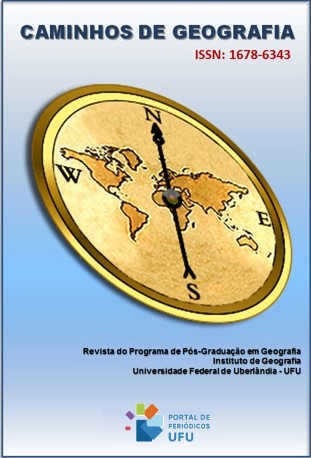CONTEXTO LITOESTRATIGRÁFICO E CONSIDERACÕES SOBRE A FORMAÇÃO DO JAZIGO FOSSILÍFERO DO MUNICÍPIO DE CRUZEIRO DO OESTE-PR
DOI:
https://doi.org/10.14393/RCG259970609Palavras-chave:
Litofaciologia, Pterossauro, Fluxo sazonal, Sequência rítmicaResumo
Esse trabalho teve por objetivo a descrição estratigráfica do jazigo fossilífero e a interpretação das condições de deposição, bem como das relações litofaciológicas da sequência sedimentar da Formação Rio Paraná, com destaque para o sítio paleontológico do Município de Cruzeiro do Oeste, no Estado do Paraná. O afloramento estudado é representado por uma sequência rítmica de estratos centimétricos, composto predominantemente por areia fina, formando uma sequência de pelo menos três estratos, intercalados por níveis argilosos milimétricos com hematita, ricos em fósseis de pterossauros. A disposição caótica destes elementos, junto ao topo de cada estrato, indica para a interpretação de uma deposição em condições de transbordamento de águas, com escoamento superficial efêmero distal, e no qual denominamos de Litofácies de Planície de Transbordamento. Essa litofácie grada de forma transicional em direção ao topo para sequência arenosa fina, com estruturas sedimentares tênues, associadas a marcas de ondas na parte basal da camada. Essa sequência foi interpretada como Litofácies de Lençóis de Areia, depositadas inicialmente em condições de maior umidade do substrato e gradando para condições mais secas em direção ao topo.
Downloads
Downloads
Publicado
Edição
Seção
Licença
Copyright (c) 2024 Edison Fortes, Rosana Natieli de Lima, Américo José Marques, Susana Volkmer, Daniela Cristina Roque, Vitor Bassi Mazzoni

Este trabalho está licenciado sob uma licença Creative Commons Attribution-NonCommercial-NoDerivatives 4.0 International License.
Autores que publicam nesta revista concordam com os seguintes termos: a) Autores mantém os direitos autorais e concedem à revista o direito de primeira publicação, com o trabalho licenciado sob a Creative Commons Atribuição-NãoComercial-SemDerivações 4.0 Internacional. b) Autores têm permissão e são estimulados a publicar e distribuir seu trabalho online (ex.: em repositórios institucionais ou na sua página pessoal), já que isso pode gerar alterações produtivas, bem como aumentar o impacto e a citação do trabalho publicado. c) Em virtude de aparecerem nesta revista de acesso público, os artigos são de uso gratuito, com atribuições próprias, em aplicações educacionais e não-comerciais.











